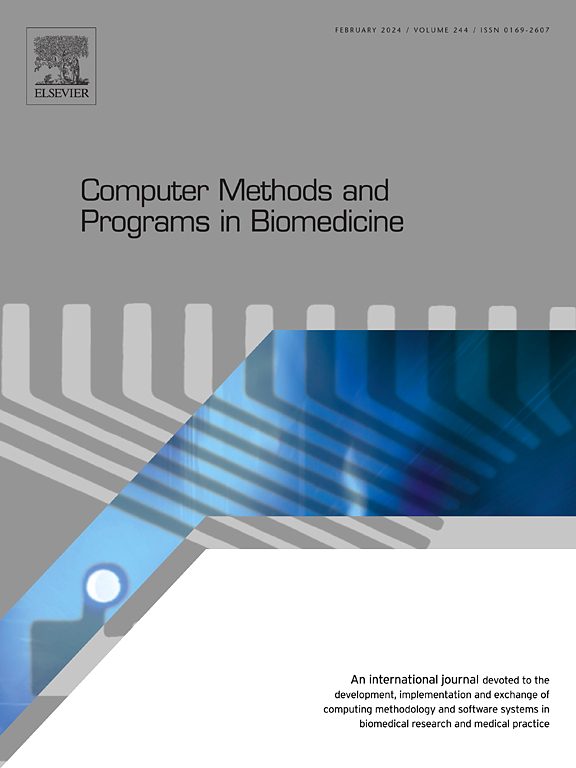Graph-theoretic characterization of nuclear spatial organization in renal cell carcinoma images
IF 4.8
2区 医学
Q1 COMPUTER SCIENCE, INTERDISCIPLINARY APPLICATIONS
引用次数: 0
Abstract
Background and Objective
Renal cell carcinoma (RCC) is a highly prevalent and aggressive kidney malignancy that necessitates accurate histopathological evaluation for effective diagnosis and treatment planning. While traditional diagnostic approaches primarily rely on nuclear morphology, emerging computational techniques offer alternative strategies to quantify nuclear spatial organization. This study leverages topological data analysis and graph theory to characterize nuclear aggregation patterns in RCC histopathological images.
Methods
Graph-based features, including Betti numbers (β₀ and β₁) and clustering coefficients, were extracted to quantify nuclear connectivity and structural organization. Nuclear segmentation was performed across multiple intensity thresholds to assess the impact of threshold variation on feature extraction. The elbow method was used to determine the optimal threshold, balancing connectivity, and structural stability. Statistical significance between tumor and normal tissues was evaluated using the Mann-Whitney U test.
Results
Betti numbers (β₀ and β₁) and clustering coefficients exhibited distinct trends across different threshold values, effectively differentiating RCC from normal renal tissue. Tumor tissues demonstrated higher β₁ and clustering coefficient values, indicating increased nuclear aggregation and irregular connectivity, while normal tissues exhibited higher β₀ values, suggesting a more fragmented nuclear distribution. The elbow method identified 100 pixels as the optimal threshold for feature extraction, and statistical analysis confirmed significant differences (p < 0.05) between tumor and normal tissues.
Conclusion
The results validate the effectiveness of topological and graph-based descriptors in capturing tumor-associated structural variations. By systematically evaluating intensity thresholds and selecting the optimal one, this study enhances the reliability of nuclear aggregation-based differentiation. The proposed computational framework supports automated RCC diagnosis and improves histopathological assessment, demonstrating the potential of topological data analysis and graph theory in medical imaging.
肾细胞癌图像中核空间组织的图论表征
背景和目的肾细胞癌(RCC)是一种高度流行和侵袭性的肾脏恶性肿瘤,需要准确的组织病理学评估才能有效诊断和治疗计划。虽然传统的诊断方法主要依赖于核形态,但新兴的计算技术提供了量化核空间组织的替代策略。本研究利用拓扑数据分析和图论来表征RCC组织病理图像中的核聚集模式。方法提取贝蒂数(β 0和β 1)和聚类系数等基于图的特征来量化核连通性和结构组织。通过多个强度阈值进行核分割,评估阈值变化对特征提取的影响。肘部法用于确定最佳阈值、平衡连通性和结构稳定性。使用Mann-Whitney U检验评估肿瘤组织与正常组织之间的统计学意义。结果betti数(β 0和β 1)和聚类系数在不同阈值上表现出明显的趋势,可以有效地区分肾细胞癌和正常肾组织。肿瘤组织的β₁和聚类系数值较高,表明核聚集性增加,连通性不规则,而正常组织的β₀值较高,表明核分布更碎片化。肘部方法确定了100个像素作为特征提取的最佳阈值,统计分析证实了显著差异(p <;0.05)。结论该结果验证了拓扑描述符和基于图的描述符在捕获肿瘤相关结构变异方面的有效性。本研究通过系统评估强度阈值并选择最优阈值,提高了核聚集分类的可靠性。提出的计算框架支持RCC的自动诊断和改进组织病理学评估,展示了拓扑数据分析和图论在医学成像中的潜力。
本文章由计算机程序翻译,如有差异,请以英文原文为准。
求助全文
约1分钟内获得全文
求助全文
来源期刊

Computer methods and programs in biomedicine
工程技术-工程:生物医学
CiteScore
12.30
自引率
6.60%
发文量
601
审稿时长
135 days
期刊介绍:
To encourage the development of formal computing methods, and their application in biomedical research and medical practice, by illustration of fundamental principles in biomedical informatics research; to stimulate basic research into application software design; to report the state of research of biomedical information processing projects; to report new computer methodologies applied in biomedical areas; the eventual distribution of demonstrable software to avoid duplication of effort; to provide a forum for discussion and improvement of existing software; to optimize contact between national organizations and regional user groups by promoting an international exchange of information on formal methods, standards and software in biomedicine.
Computer Methods and Programs in Biomedicine covers computing methodology and software systems derived from computing science for implementation in all aspects of biomedical research and medical practice. It is designed to serve: biochemists; biologists; geneticists; immunologists; neuroscientists; pharmacologists; toxicologists; clinicians; epidemiologists; psychiatrists; psychologists; cardiologists; chemists; (radio)physicists; computer scientists; programmers and systems analysts; biomedical, clinical, electrical and other engineers; teachers of medical informatics and users of educational software.
 求助内容:
求助内容: 应助结果提醒方式:
应助结果提醒方式:


